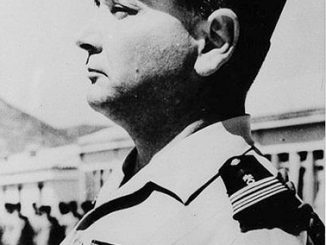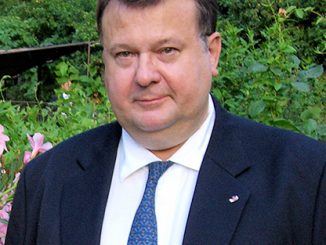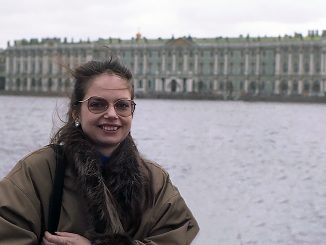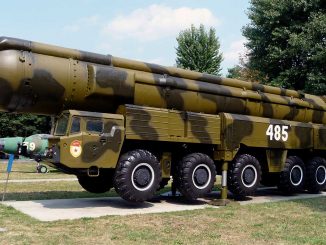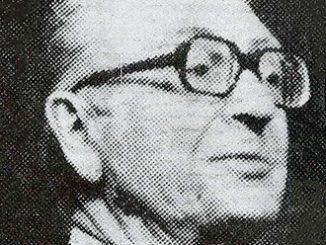The US has the best led, trained and equipped military force in the world. Since WW II, fielding technologically superior forces has been the cornerstone of our national military strategy allowing our forces to deter, and when deterrence failed, prevail over numerically larger enemy forces.
Statement of The Under Secretary of Defense for Acquisition and Technology, Honorable Paul G. Kaminski, Before the Acquisition and Technology Subcommittee of the Senate Committee on Armed Services on DOD FY 1998 Acquisition and Technology Program, March 11, 1997 — Source: DoD.
Mr. Chairman, Members of the Subcommittee, and staff, thank you for the opportunity to appear before you today to discuss the Department of Defense Acquisition and Technology Program.
The United States has the best led, trained and equipped military force in the world today. Since World War II, fielding technologically superior forces has been the cornerstone of our national military strategy.
This advantage has allowed our forces to deter, and when deterrence failed, prevail over numerically larger enemy forces. Our predecessors invested wisely in technology in the 1960s and 1970s. The result was an overwhelming, swift, decisive victory in Desert Storm in 1991, an equally decisive NATO air campaign in Bosnia in 1995 that opened the way to the Dayton Peace Accords later that year, and a continuing deterrence of our potential adversaries.
Mr. Chairman, the strategic focus of the defense acquisition and technology program is on fielding superior operational capability, fielding that capability in the shortest possible amount of time, and fielding that capability at the lowest possible life cycle cost. Our vision for the present and the future is best captured in three words-better, faster, cheaper. We have maintained this focus for some time now. And so, as impressive as our military accomplishments were in Desert Storm and Bosnia, our forces are qualitatively superior today.
This would not have been possible without the help and support from the Members of this Subcommittee.
Working together, the Congress and the Department have invested in a strong science and technology program; improved our management of DoD-sponsored Federally Funded Research and Development Centers; initiated a high leverage program of Advanced Concept Technology Demonstrations; launched an innovative, new Dual-Use Applications Program; established a framework for reducing, restructuring and revitalizing the Department’s RDT&E infrastructure; and have taken steps to improve the quality while reducing the size of the DoD acquisition workforce. We are also implementing a broad program of acquisition reform-the subject of a future hearing before this Subcommittee later this month.
INVESTMENT BUDGET
We have made very tough choices because of the need to balance the federal budget and the resultant budget top line for defense. The President’s FY 1998 budget request contains $35.9 billion for RDT&E and $42.6 billion for Procurement. We continue to emphasize Science and Technology with an FY 1998 budget request of $7.4 billion to assure future war fighting superiority.
On a constant dollar basis, the 1962-1998 historical norm for the ratio of expenditures on procurement to those for R&D has been about 2.3 to one. In the 1998 budget request, the procurement-to-R&D ratio is 1.2-an all-time low. To invest for long-term readiness and capability, it is necessary to begin spending more money on the procurement of new systems. It would be a mistake to do this at the expense of the RDT&E account. Maintaining our critical technology advantage requires substantial investment-we can not afford to greatly reduce our investment in RDT&E.
Consistent with these goals, spending for procurement is projected to increase to $60 billion and planned RDT&E spending levels off to about $33 billion per year by 2001. These goals are being reviewed in the Quadrennial Defense Review along with force structure and infrastructure. This review is looking fundamentally at strategy, size and nature of forces, supporting infrastructure, and the need to improve stability for our investment program.
SCIENCE AND TECHNOLOGY PROGRAM
One point that I made before the Subcommittee in the last two years, but one that always needs emphasizing, is that stable, sustained investments in science and technology are required to create technology « on-ramps » for revolutionary new military capabilities. A long commitment to this strategy is required over years and decades to achieve significant results; it is not possible to wait until a specific advanced technology is clearly needed in a system to begin investment; by then, it is too late.
Today’s leading edge systems were made possible through decades of investment in fundamental science and exploratory development work. The technology base initiated in the 1960’s and the technology « on-ramps » sustained in the 1970’s gave us the stealth aircraft, precision guided munitions, and night vision systems that provided U.S. forces with a decisive combat edge during the 1991 Gulf War. The Department, with the FY 1998 S&T budget request, continues to make a focused, robust investment in technologies to address the new threats of a changing world and emerging war fighting concepts of the 21st Century.
S&T Strategic Planning Process
Over the last year, we have continued to strengthen our science and technology strategic planning process. The Office of the Secretary of Defense, Joint Staff, Military Services and Defense Agencies have again worked together very closely to generate and publish our strategic S&T plans:
- the Defense Science and Technology Strategy;
- the Basic Research Plan;
- the Defense Technology Area Plan, and
- the Joint Warfighting Science and Technology Plan.
The Department has taken these steps to ensure the S&T program is militarily relevant and technically sound.
As required by Public Law 104-201, Section 270, the Director of Defense Research and Engineering has delivered copies of the Joint Warfighting Science and Technology Plan to the Committee. This plan details those applied research and technology demonstrations which are included in the budget request to provide the advanced technology and advanced joint warfighting concepts required to achieve Joint Vision 2010. The development of this plan was a team effort between the warfighting, acquisition, and technology communities. The ten Joint Warfighting Capability Objectives cited in this Plan were approved by the Joint Requirements Oversight Council. These objectives set our sights far into the future, so that this Plan provides a roadmap, starting from the technology opportunity of today to the delivery of technology based elements needed by our forces decades hence. The Plan details crisp milestones against a schedule and a budget.
The companion Defense Technology Area Plan presents our DoD investment strategy and Defense Technology Objectives for the ten technology areas spanning all of our 6.2 and 6.3 program. Our 6.1 basic research investment plan and strategic research objectives are documented in the Basic Research Plan.
All three plans and the companion Defense S&T Strategy are issued as guidance annually to the Services and Agencies. The Defense S&T Reliance organization, under the direction of the Director for Defense Research and Engineering, is a pivotal part of this planning process. The Reliance organization drafts the S&T strategic plans and is responsible for defending our budget allocations, and our progress against some 286 technology objectives spelled out in these plans to independent Technology Area Review and Assessment panels that convene annually in a week-long, rigorous review process. These independent panels are comprised of some of this nation’s leading industry, academic and retired military scientists and engineers from such prestigious organizations as the National Academy of Sciences, National Academy of Engineering, Institute of Medicine, Service science advisory boards and the Defense Science Board. Over the last few years, Reliance has been catalyzed into being a strong corporate forum that plays an important part of our DoD-wide program planning process.
These plans are provided not only to government offices and Congress, but also to industry and academia so they can better focus their research investments on our priorities. This not only aids the development of the right technology for our modernization needs; it speeds technology transition, and helps us leverage the private sector, defense and commercial industry technology investments.
Countering Mines
We have increased our investment in countering mines both on the battlefield and also during operations other than war. This is a very active area of research in both the Department of the Army, managed by the Night Vision Electronic Sensors group at Fort Belvoir, Virginia, and the Department of the Navy, managed by Naval and Marine Expeditionary Warfare units. Their combined investment is over $62 million in joint counter mine and humanitarian de-mining and includes several Advanced Technology Demonstrations and Simulations in the areas of land and water mine countermeasures, hunting, clearance and force protection, along with battlefield and naval surveillance, reconnaissance and targeting requirements.
Another $7.6 million is requested for a humanitarian de-mining technology demonstration program led by the Assistant Secretary of Defense for Special Operations and Low Intensity Conflict (ASD(SO/LIC)). Because we are technology limited in our ability to detect mines rapidly and with sufficient confidence, we have made three awards of $1 million per year, for at least three years to prestigious university and industry teams led by the California Institute of Technology, Duke University and the University of Missouri at Rolla. Incremental technology development is not solving the problem; we look to the basic research community for creative new approaches for countering mines and they are being very creative indeed. Several new ideas on countering mines have already been proposed including the use of miniature robots or insects to locate and neutralize mines, dissolving agents and disrupters, and a mechanical « dog nose » that can sniff for explosive materials.
Information Technology
The science and technology program is increasing emphasis on information technologies. In addition to having effective mission planning systems, effective C4ISR (Command, Control, Communications, Computers, Intelligence, Surveillance and Reconnaissance) is needed for battlefield visualization and dominant battlefield awareness. To achieve this capability, we are moving large scale « system-of-systems » architectures with global span and highly networked, mobile elements. It places a premium on being able to put together complex software and various legacy components that we have developed previously in the way of sensor systems, communication systems and weapon systems.
Our technology base is supporting a number of new C4ISR systems that will be coming on line. C4ISR systems like the Predator Unmanned Aerial Vehicle (UAV) and JSTARS help ensure that US forces possess an overwhelming capability of « information dominance » to direct precision strikes. Just as the United States possessed an overwhelming nuclear capability and extended a « nuclear umbrella » over our allies during the Cold War, so too will the United States extend an « information umbrella » over our coalition partners in the 21st Century.
Modeling & Simulation High Level Architecture
The Department of Defense, through adoption of a Modeling and Simulation Master Plan in October of 1995, has begun to move forward on a more coherent strategy for improving oversight and coordination of DoD modeling and simulation activities. In a budget constrained environment, we simply cannot afford to waste dollars on redundant, stove-piped efforts-we need to be able to get more mileage out of the models and simulations we build.
In an environment that is increasingly joint, often coalition, and involving system of systems architectural trades, we must be able to link simulations together and interoperate them in federations. To do that we have to find ways to facilitate their interoperability and reusability. DoD modeling and simulation activities need to be anchored in a common technical architecture and interchange data which is both authoritative and means the same thing to everyone.
To be cost-effective, they must also share common infrastructure services like communication networks, a rapid means to access environmental databases, a distributed repository system to find and pull-down existing models and simulations, and a help desk to answer questions from users on setting- up a simulation exercise.
The cornerstone of our efforts for fostering interoperability and reuse is the High Level Architecture, or HLA. The establishment of HLA-compliant simulations will be an important milestone in maximizing the benefits of modeling and simulation across the Department of Defense. This past year we have not only reached agreement on the right high level architecture and rules for distributed simulation in the United States, but we are also working more closely with our NATO allies. Mr. Chairman, I am pleased to report that routinely interoperable military simulation data and software components appear to be an emerging reality.
Government-Industry-University Research
I am asking your support this year for our new Government-Industry-University budget line. There is a real opportunity for DoD to leverage industry funding for basic research performed by university consortia.
In the U.S. today, universities are the principal performers of long-term research. Industry has reduced the size of its in-house research laboratories, and its investment is oriented more towards near-term applied research, rather than long-term basic research. Yet, the DoD and other government agencies have mission-driven reasons to seek long-term research advantages in relevant technologies.
The Department must find a way to fund and execute long-term research and to leverage the strengths of government, industry, and the universities. This proposed new initiative calls for a three way partnership between the government, industry, and universities. Funds would be provided by both the government and industry to university centers. Government would ensure that research remained long-term in nature and mission-relevant. Industry would ensure that the research had promise for delivering commercially successful products.
This would provide a new mechanism to link universities (the long-term research performer) with industry (the short term product producer), doubling the level of industry investment in strategically directed research focus areas and creating a long term focus consistent with our national security objectives.
Manufacturing Technology (MANTECH)
The DoD Manufacturing Technology Program is unique in both focus and scope. Unlike any other DoD program, MANTECH focuses on the development of process technology. Generally, the development of process technology has been relegated to the production contractor who produces a weapon system. In this environment, MANTECH seed funding helps incentivize industry to make large investments in low cost process technology.
MANTECH addresses production issues from system development through transition to production and in-service sustainment. Although every segment of the life-cycle is important, the transition from advanced technology development to production is critical. By identifying production issues early and providing timely solutions, MANTECH reduces risk and positively impacts system affordability by providing solutions to manufacturing problems before they become severe.
The program is executed with DoD prime contractors, subcontractors, suppliers, hardware and software vendors, industrial consortia, centers of excellence, universities, and research institutes. Oversight is provided by the Director, Defense Research and Engineering to the Service and Agency S&T Executives. The program is managed through the MANTECH Tri-Service/Agency technology panel. Technical projects are coordinated and executed by technical subpanels, including Advanced Industrial Practices, Manufacturing Engineering and Systems, and three Processing and Fabrication subpanels – Electronics, Metals, and Composites.
DoD policy is for MANTECH to address defense driven manufacturing issues that are beyond the risk threshold for industry investment. Congress now requires 25 percent of the available funds each fiscal year be used for awards having a recipient to government ratio of two to one cost sharing. Cost sharing for MANTECH is appropriate where risk has been lowered or there is a commercial market application that warrants contractor investment. In fact, the results of a recent survey indicates MANTECH programs are garnering an average of 20-30 percent cost share from recipients. However, sustaining 2:1 cost share for 25 percent of available funds may prove excessively burdensome over time. It is an artificial constraint that I urge the Congress to remove in the FY 1998 Defense Authorization Act.
As a 6.3 program element in OSD and the Services in FY 1994-1995, MANTECH investments focused on maturing manufacturing processes earlier in the acquisition cycle, providing an up-front focus for cost reduction and affordability. The result was investments in longer term, pervasive, technology driven programs focused on affordability, including items like the Virtual Manufacturing Initiative and Insertion of Lean Manufacturing Practices in the Aerospace Sector.
To satisfy Congressional direction for a closer linkage to weapon systems programs, MANTECH was transferred to the Services and DLA in FY 1996. In response, Service acquisition managers look to MANTECH as a mechanism to address rapid response, shorter-term production, sustainment, and logistics manufacturing solutions like Large Aircraft Paint Stripping and Advanced Manufacturing Techniques for Gas Turbine Engines that are targeted for specific weapon system customers. In this way, MANTECH is beginning to address our important life-cycle process issues.
FEDERALLY FUNDED RESEARCH AND DEVELOPMENT CENTERS
As I have testified consistently before the Congress, Federally Funded Research and Development Centers (FFRDCs) are a very critical national asset. I believe so for four basic reasons.
- One, they maintain long-term strategic relationships with their DoD sponsor.
- Two, they perform the research, development and analytic tasks that are integral to the mission and operations of their DoD sponsor.
- Three, they maintain « core » competencies in areas important to their sponsors and employ this expertise to perform high quality, objective work that cannot be carried out as effectively by other private or public organizations. And
- Four, they operate in the public interest, free from real or perceived conflicts of interest.
These are really the four key underlying reasons why FFRDCs are indispensable to national security. As the Department downsizes, FFRDCs have become increasingly important as centers of independent technical expertise and support.
These factors were among the considerations which led a Defense Science Board Task Force to conclude in their independent review about two years ago in April of 1995 that: « FFRDCs should be retained on the strength of their quality and the special relationships they have with their sponsor’s on matters of great importance to the DoD. » And incidentally, nearly every single independent review and every inquiry that I have conducted has come back to confirm this basic conclusion.
My bottom line is that I believe-and this belief is held widely in the Department, both by civilian and military leaders-that FFRDCs are doing high-quality, high-value technical and analytic work that could not be provided as effectively by other means. Mr. Chairman, let me assure you that the people who are complaining about FFRDCs are not the users of their services or the recipients of their products. FFRDCs are doing their jobs for DoD and they’re doing them well.
The essence of their value to DoD lies in the qualities that I mentioned previously, starting with the long-term strategic relationship. I might note that this is one area where DoD has been in front of the commercial sector in its acquisition practices. Successful commercial firms are moving increasingly in the direction of establishing long-term, strategic relationships with their key suppliers. They have found the result is often a higher quality product, at lower overall costs, in contrast to the previous practice of changing suppliers based on recurring, short-term low bids. DoD has long realized this benefit from FFRDCs.
I am not arguing that competition is inappropriate. The Department uses competitive processes to obtain the overwhelming majority of the goods and services that we require. But there are some circumstances and some kinds of work, for which the value provided by a strategic relationship far outweighs the potential gains of competition. Even in a long term relationship, if we are dissatisfied with the work performed, we have the opportunity for a « dissimilar competition » and outsource that work with another FFRDC.
The Department has strengthened its management of FFRDCs to ensure the most effective and prudent use of the centers while providing measures to guard against abuse. The work content and the operations of each of these centers have been closely scrutinized over the past year. FFRDCs are sized consistent with essential sponsor requirements, acquisition reform initiatives, and defense strategies and budgets. We have strengthened our management controls, including managing the workload of our centers to the core concept; transitioning on-going work that is non-core out of the centers; and establishing consistent management fee guidelines.
In summary, the Department has responded to the legitimate concerns of the Congress. We have implemented needed management reforms and it is now time to restore the normal process for fiscal oversight of FFRDCs. Accordingly, we are requesting the four Defense oversight Committees to discontinue the practice–started a few years ago–of inserting special language in annual Authorization and Appropriation bills to limit DoD spending at FFRDCs. Such measures are no longer needed and they unnecessarily constrain DoD’s ability to effectively and efficiently use FFRDCs for appropriate national security tasks. As required by statute, the Department will continue to report it’s actual use of Staff Technical Equivalents (STEs) at FFRDCs for the past fiscal year and projected STEs for the next fiscal year on an annual basis.
On a final note, there is one Congressionally-imposed constraint on FFRDC operations that I would seek your support in removing for FY 1998. For the past two years, the Appropriations Acts have capped payment to FFRDC consultants at the GS-15 level. Not surprisingly, many of the top researchers in industry and academia-particularly in the information and computing sciences-are paid at much higher rates when they work for private firms or for other defense contractors. While the overwhelming majority of FFRDC work is performed by in-house staffs, on occasion DoD asks FFRDCs to examine issues that require temporary access to the nation’s most talented scientists and technical specialists. The salary cap on FFRDC consultants is limiting DoD’s access to these individuals and thus I request your support in removing this constraint.
ADVANCED CONCEPT TECHNOLOGY DEMONSTRATIONS
You may have heard of the Department’s studies of a « Revolution in Military Affairs » or RMA. The revolution derives not from a single innovation or idea but from a fundamental change in the way America fights and employment of new war fighting concepts. In many cases, the technology associated with a new system or concept is mature and the technical risk is low, but the operational risk of the new warfighting concept is high. In order to gain acceptance in the field, the advanced technology must be married with a suitable employment doctrine. This is one thing that I think has not been given adequate emphasis in the past. We have traditionally underestimated the importance of developing the appropriate doctrine, the tactics for employment, the training, and the people who use technologically advanced systems.
Advanced Concept Technology Demonstrations (ACTDs) are designed to rapidly transfer technology from the developers to the users by focusing on concept–not technology-risk reduction. ACTDs provide a framework by which we seek out emerging technologies to respond to our more critical military needs and incorporate those technologies into fieldable prototypes. These prototypes are then placed in the hands of our war fighters for evaluation. The fundamental question posed to the war fighter during the ACTD is « does this capability respond adequately to the need? » Where the answer is yes, we can field that capability years earlier than would otherwise be possible.
The use of fieldable prototypes to evaluate a proposed new military capability pays very large dividends in a number of ways. First it allows our military users to explore new tactics, concepts of operation and doctrine to fully exploit these new capabilities. Second, ACTD evaluations occur in their intended use and with their intended users rather than solely on a test range. This permits the user to judge the true contribution that the proposed system will make, recommend adjustments to improve performance and do so before an acquisition decision is made. In today’s budget environment, we must chose carefully how we invest in modernization. With ACTDs, we give the war fighter an opportunity to use before we chose.
A third ACTD benefit is that operational demonstrations permit us to focus the technical specifications on the military mission and not « over engineer » them to stress system aspects which are not necessarily military significant. « Fieldable prototype » demonstrations permit us to more effectively define the operational requirements prior to entering into quantity procurement. A fourth benefit realized from the use of fieldable prototypes is the ability to leave the ACTD residual systems with the user to provide a limited operational capability.
Fifth, ACTDs foster a close teaming relationship between our military operators and the developers/technologists who are providing the new capability. This relationship results in a better understanding of the military needs and constraints by the developers/technologists and a better understanding of the potential capability by the operators. On a broader level, we see that organizations like the United States Atlantic Command in Norfolk, Virginia, are engaged in constant dialogue with the technical sponsors, such as DARPA, of each of those ACTDs.
Finally, ACTDs, under the sponsorship of a unified commander, can serve as a critical agent in fostering joint interoperability. A single ACTD will commonly draw technologies from multiple sources including service laboratories and defense agencies. In doing so they focus each of these organizations on the full scope of the military need, including interoperability.
I would like to highlight some of the significant operational results and progress we have achieved with a number of our ACTDs. Of the twenty-three ACTDs we have started in Fiscal Years 1995 and 1996, we have completed six. I expect we will complete three more during this calendar year.
The most visible ACTD, and one of the first to be completed, was the Predator Medium Altitude Endurance UAV, which is now deployed in support of Operation Joint Endeavor. The Predator air vehicle is about 49 feet from wing tip to wing tip. The fuselage is 27 feet long. It’s max weight is 1873 lbs-about 450 lbs of that is the payload. The payload contains two sensor packages-a synthetic aperture radar and an electro-optical/infra-red package. It has a 500 nautical mile range and an endurance on station at this range of 24 hours.
Perhaps the most amazing aspect of this ACTD is that we went from concept to first flight in just six months-from January 1994 to June 1994. The ACTD was completed in June 1996-30 months after program start-after proving military utility in the Roving Sands ’95 air defense exercise, supporting UN forces operating in Bosnia in 1995, and again providing support to NATO forces in 1996.
In June of 1996, the submarine and special operations community just completed a very successful demonstration using the Predator UAV to integrate attack submarines in the nation’s larger system-of-systems C4ISR architecture. A nuclear attack submarine, the USS CHICAGO, took control of the Predator Unmanned Aerial Vehicle in a demonstration with Navy SEALs off San Clemente Island, California.
This effort is a significant first: it is the first example of a Predator vehicle and sensors being controlled from a Navy submarine. Some people in the submarine community have commented that « this is the most exciting thing that has happened in submarine warfare since the nuclear reactor. » I agree with them-rather than having a 15 foot periscope, the submarine effectively had a 15,000 foot periscope.
The submarine was configured with a super high frequency 23 dB gain flat plate antenna, similar to that used for direct broadcast TV, except adapted for seagoing conditions unique to submarines. A SUN SPARC workstation was used for directional control of the antenna. A JDISS terminal was put on-board to insure a video re-broadcast at 32kilobits-per-second.
The Predator was directed to conduct target surveillance in order to plan a real-time SEAL insertion-including dynamic re-tasking and bomb damage assessment. The demonstration included control of the UAV from the submerged attack submarine at periscope depth from a range of about 100 nautical miles.
This April we expect to the Predator to enter into production-just a little over three years from program start. Predator was a tremendous learning experience for us in understanding both the military value that results from rapid fielding of a critical new capability and in highlighting the challenges that we must meet in order to achieve our initial objective of more quickly developing and fielding new systems. We will continue to exploit the lessons learned on how to conduct military assessment and transition ACTDs to acquisition.
In October 1996, we concluded the Counter Multiple Launch Rocket ACTD, which dealt with the severe threat posed by the North Korean multiple launch rocket capability located just north of the Demilitarized Zone and within range of Seoul. This ACTD demonstrated and fielded significant improvements in capability related to rocket launch detection, command and control and counterfire, necessary to effectively deal with this threat. Times required to respond to multiple launch rocket attacks were reduced from 15-20 minutes to 3-4 minutes and the accuracy of the counterfire was increased dramatically. This ACTD was initiated as an all Army effort but, as it progressed, was expanded to include significant participation and contribution by both Navy and Air Force units. Major General Franks, the Commanding General of the 2nd Infantry Division in Korea said, « the way we need to put technology into the Army for the future is just the way we did it for this Counter MRL ACTD. The soldiers have had a chance to play with it and influence the outcome. . . «
General Joulwan, Commander-in-Chief, U.S. European Command (USEUCOM), as the operational sponsor, clearly articulated the purpose of the Counter Proliferation ACTD as being « to develop, integrate, demonstrate and transition to the war fighters a military ready capability to destroy WMD-related facilities. » Initiated in Fiscal Year 1996, this ACTD is still in progress but has already demonstrated some significant results. In December 1996, a full « end to end » demonstration of the capability to accurately characterize, target and destroy a storage facility for weapons of mass destruction was successfully accomplished.
The Air Base/Port Biological Detection ACTD was also initiated in Fiscal Year 1996. Its objective is to provide significant enhancements in biological detection capabilities to military installations and responds directly to requests from several CINCs. This capability has already been fielded and site surveys are presently underway for expanded operational deployment later this year. The Commander of the Marine Corps Systems Command has requested procurement of additional systems to support the Marine Corps Chemical/Biological Incident Response Force.
ACTDs are an important part of our overall acquisition reform program and our plans to improve acquisition support to the war fighter. When you have a system or a capability that is leading and you are comfortable with it, which the American military has today, it is very difficult to bring along a new capability that will displace the one that you are leading with today. ACTDs help us break those institutional barriers down. They are a catalyst for stimulating innovation because they provide a low cost, low risk mechanism for integrating and evaluating the advanced technologies, the unconventional operational concepts, and the new organizational structures needed to bring about the revolution in military affairs.
I ask the Committee to give its full support to the Department’s Advanced Concept Technology Demonstration initiative and to the President’s budget request for ACTDs. I invite you and members of your staff to review the results of completed or ongoing ACTDs, and later this year, to examine those additional ACTDs we will select for initiation in Fiscal Year 1998.
DUAL-USE APPLICATIONS PROGRAM
A major focus of our acquisition program is to reduce the life cycle cost of our new and existing systems. On new systems, it means paying attention to life cycle costs early in the design of a new system. However, given the limited rate at which we are introducing new systems to replace those already in the field, we simply cannot wait for the new weapon system development process to solve our growing problem with the increasing costs to operate and support our existing systems in the inventory today. Our system must have the proper incentives to insert new low cost technologies in our legacy systems to improve their reliability, maintainability, and sustainability.
The Department also must take advantage of the opportunity to apply commercial technology and products to enhance our military capability and lower the life cycle costs of our weapon systems. Commercial investment in R&D now easily surpasses that of the DoD, by a margin of two to one. This large commercial investment in R&D means that the commercial sector is the driving force behind much of the technological innovation in the US today. The Department’s S&T program must leverage this technological innovation for the benefit of military capability.
The Dual-Use Applications Program (DUAP) mission is to develop, test, and then transfer to the Services new approaches to leveraging the commercial sector’s research, technology, products, and processes for DoD’s benefit. We have two primary goals. One, DUAP will increase leveraging of the commercial sector across the acquisition spectrum. Two, and as important, DUAP must institutionalize these new dual-use approach in the Services. We want to move dual use and leveraging from concepts centered in the Office of the Secretary of Defense to ones centered in the Services. We must make these new ways of doing business the normal way of doing business.
More specifically, this year the DUAP consists of two initiatives; the Science and Technology Initiative and the Commercial Operations and Support Savings Initiative (COSSI). The DUAP FY 1997 budget is divided between these two Initiatives — $85 million for the Science and Technology Initiative and $100 million for the COSSI. Both of these programs are underway and include cost sharing with industry. A brief description of each follows.
Science & Technology Initiative
As previously discussed, the Department of Defense must increase the use of commercial technology to reduce the costs and increase the capabilities of our defense systems. One way to do this is to join with industry in the development of dual use technologies. The Science and Technology Initiative will facilitate this joint development by taking the lessons learned during our earlier dual-use efforts and initiating a dual-use technology development program in the Services. This will be done through:
- education of the Services on the use of flexible contracting mechanisms such as 10 U.S.C. Section 2371 « Other Transactions » and Cooperative Agreements;
- transition of the techniques developed and knowledge gained by DARPA during the execution of prior dual use programs; and
(3) initiation of pilot dual use development programs in the Services.
The process has begun. The Services have been asked to identify proposals from industry for the DUAP S&T Initiative. Proposals are due on May 30, 1997. Nominated projects must meet the following criteria:
Dual Use Technology – If successful, the project will result in the development of a technology that has both military relevance and sufficient potential commercial applications to support a viable production base.
Cost Sharing – At least 50 percent of the cost of the project will be provided by industry. The remaining cost of the project (50%) will be equally shared by the sponsoring Service and the DUAP.
Competitively Awarded – Project awards to industry must be based on competitive procedures and based solely on merit.
Innovative Contracting Agreements – Contracts must be awarded using non-procurement agreements, i.e. Cooperative Agreements or « Other Transactions. »
The sharing formula that we are planning to utilize will result in the Services obtaining a four-to-one leverage of their science and technology dollars and will provide the kind of incentive needed to establish a dual use technology development program in the Services. As dual use science and technology is the most « mature » leveraging approach, the DUAP is actively transferring these techniques to the Services through incentives and learning by doing. Commercial Operations and Support Savings Initiative
The DUAP Commercial Operations and Support Savings Initiative, or COSSI, will combine life cycle cost containment with leveraging commercial technologies. It will take our dual use efforts in a new and exciting direction — COSSI will support the retrofit of fielded military systems with commercial technologies to decrease the cost of operations and support of these systems.
What’s new here is that we are using commercial technologies, not only for newly developed systems, but for fielded systems. And although we may realize benefits in increased performance, or decreased development or acquisition costs, our real focus is on life cycle costs. These are major differences from the past. In COSSI, the Acquisition Executives of the Army, Navy and Air Force have the lead. The Service acquisition communities will help choose the commercial products and processes that make sense for their fielded military systems. They must work closely with commercial industry and the weapons system prime contractors to engineer and adapt the commercial product for the specific weapon system, and test the product to insure that it achieves at least comparable performance at a decreased operations and support cost. In fact, we will require that industry include a statement of support from the Military Service customer as a formal part of their team proposal. This is the culmination of DoD’s trend toward partnership with industry for mutual benefit, which is key to so many of our acquisition reform efforts.
Perhaps the most exciting aspect of COSSI is that it will prototype an innovative acquisition approach for weapon system upgrades. For the development and testing of what we are calling the modification kits, the Services will use Section 845 prototyping agreements which are not constrained by the sometimes inflexible government policies and standards found in our cumbersome procurement system. These agreements allow prime contractors to apply Independent Research and Development funds to cost share, and to use commercial practices that attract commercial partners to the development team.
These Section 845 agreements have been used for the past three years by the Defense Advanced Research Projects Agency in an experimental mode. The government and industry, as a team, negotiate sensible terms for intellectual property rights, accounting and auditing practices and sharing of costs.
COSSI will validate a new, commercial-like approach for prototyping and procuring upgrade kits — an approach that can be used on an expanded basis in years to come. And with the DUAP Science and Technology Initiative, we will continue to have access to state-of-the-art commercial technology for our developing weapons systems. DUAP’s two-pronged strategy of commercial upgrades and dual use research and development will help the Department take greater advantage of commercial industry’s research, technology, products, and processes at
every stage of the acquisition life cycle.
RDT&E INFRASTRUCTURE – VISION 21
Based on provisions in the National Defense Authorization Act for Fiscal Year 1996, the DoD is preparing a plan for its Laboratories and Test and Evaluation (T&E) Centers for the 21st Century. This plan, called Vision 21, will be based upon requirements to support the research, development and engineering, and test and evaluation (T&E) for current and future weapon systems and will identify the critical laboratories and T&E Centers needed to do so.
The Vision 21 plan will rest on three implementing and integrating pillars:
- Reduction,
- Restructuring (intra-Service and cross-Service), and
- Revitalization. Our objective is to attain a modern, efficient, and effective Laboratory and T&E Center environment with focus on the costs of facilities and infrastructure. Vision 21 will include development and assessment of options to reduce the cost of the DoD Laboratory and T&E infrastructure each by at least 20 percent beyond the baseline defined by the completion of all planned Base Realignment and Closure (BRAC) actions. The adopted plan will be implemented over a five year period (FY 2001-2005). A report on the approach was submitted to the President and to Congress April 1, 1996.
Background
During BRAC’95, joint cross service groups determined that the DoD has an over capacity in Laboratory capability and in some areas of T&E. Despite this determination, the BRAC process resulted in very little adjustment to our RDT&E infrastructure. The time line for the BRAC process ran out before a definitive plan could be developed in response. The need for a study to develop such a plan was recognized by the Congress and the DoD and has lead to our Vision 21 effort.
For purposes of Vision 21, Laboratories are defined broadly to include any DoD activity that performs one or more of the following functions: science and technology; engineering development; systems engineering; in-service support of deployed material and its modernization. Labs and T&E activities together account for 105 sites and encompass approximately 130,000 personnel, including on-site contractors. It is estimated that labs and T&E organizations expend approximately $10 billion in house and about one half of that is expended in overhead functions. A goal of the study is to reduce such overhead (infrastructure) costs by 20 percent. A Baseline Cost Determination data call will be issued this spring to establish the baseline costs of lab and T&E infrastructure.
Process
I chair an Integrated Product Team (IPT) to guide this effort. The plan baseline will be the DoD laboratory and T&E center infrastructure as of the completion of all BRAC-related actions. Any non-BRAC consolidation / downsizing taking place after May 1, 1996 may be used to meet the study objectives. Both intra-Service and cross-Service approaches will be studied; the Laboratories and T&E Centers will be studied by separate teams at the onset, but the studies will be joined early on to provide a coherent set of options for further study and closely linked with the Quadrennial Defense Review (QDR).
Specific criteria for the plan have been provided by both Congress and the Office of the President. In addition to these criteria, the plan will determine the minimum essential set of capabilities, facilities, and installations necessary to maintain defense technological superiority and required capacity in a rapidly evolving threat environment. It will compare the existing capabilities, facilities, and installations with the minimum essential set to quantify the necessary level of reduction and restructuring.
Legislation
The intent of the DoD is to form a strong partnership with Congress in achieving Vision 21. Clearly, Congress will need to enact appropriate enabling legislation if Vision 21 is to be implemented pursuant to the schedule stipulated by Section 277 of the National Defense Authorization Act for Fiscal Year 1996. Accordingly, the « DoD Research, Development, Test and Evaluation, Vision 21, Reduction, Restructuring and Revitalization Act of 1998 » has been drafted and will be forwarded to the Congress.
Significant Closures & Reductions
Vision 21 will build on previous efforts to create an efficient, effective, right-sized DoD Laboratory and T&E Center infrastructure. While excess capacity remains, four rounds of BRAC have led to a significant number of closures, consolidations and realignments, and others are scheduled to be completed by FY 2001. The Services have also taken their own initiatives to complement the BRAC actions by streamlining their Laboratory and T&E Center structures, facilities, workforce, and procedures. A 35 percent reduction in the RDT&E workforce from FY 1990 to FY 2001 is reflected in the FY 1998 President’s Budget.
Reinvention
Reinvention Laboratories under the National Performance Review are pursuing changes to existing laws and waivers to unnecessary regulatory guidance. Of particular note is the Congressionally authorized (National Defense Authorization Act for Fiscal Year 1995) Civilian Personnel Demonstration Program in the Service laboratories. The Laboratory Quality Improvement Program (LQIP) has championed the Personnel Demos and has also addressed reinvention of financial management, contracting and facilities construction issues. The « Vision 21 Act », as proposed, will provide the authority for further reengineering of personnel, procurement and facilities business practices.
Schedule
The process to consider consolidation and restructuring alternatives is just now beginning. A detailed process plan will be developed and submitted to the Secretary of Defense for approval by July 1998. The approved plan will provide a basis for the President’s Budget for Fiscal Year 2000 provided to Congress in January 1999.
ACQUISITION WORKFORCE
The Department of Defense acquisition workforce is our most important asset to assure long-lasting reform of the acquisition system and optimizing the expenditure of ever-decreasing acquisition resources. It is through their professionalism, dedication and efforts that the DoD making significant improvements in acquisition reform.
In 1986, the Packard Commission described the DoD acquisition workforce as « undertrained, underpaid, and inexperienced. » The Commission emphasized the direct relationship between personnel reform and acquisition reform noting: « Whatever other changes may be made, it is vitally important to enhance the quality of the defense acquisition workforce – both by attracting qualified new personnel and by improving the training and motivation of current personnel. »
Over the last five years, the Department concentrated considerable effort in improving the development, education, training and utilization of our acquisition professionals. The investment in this key resource provides significant benefits. Current trends solidly indicate a good foundation, but we need considerably more work to ensure a successful transformation to a superior workforce – one of high quality, very motivated and extremely professional. This workforce must be equipped to implement numerous new reforms, execute the myriad of acquisition functions and be able to provide the goods and services to our war fighters, now and in the future.
Right-Sizing the Workforce
The Department consistently manages, actively instead of reacting to other influences, the acquisition workforce. The recent report to the Congress, « Right Sizing the Department of Defense Acquisition Workforce », responded to concerns that the workforce might be too large. As the report indicated, the Department’s plan results in a 25% smaller acquisition workforce over the five-year period, FY 1996- 2000. This is on top of a 30 percent reduction already taken over the preceding six year period, FY 1989-1995.
Section 906 of the National Defense Authorization Act mandated an FY 1996 reduction of 15,000 personnel (acquisition organization less depot skilled trades). The actual reduction was 23,802 (military/civilian). We have now achieved the two-year mandated reduction of 30,000 as well.
If the Department’s management efforts were not limited for reporting purposes by the depot skilled-trades exemption, the actual realized personnel reduction was 30,377 in FY 1996, in these same organizations. Further, the Department estimates a two year reduction (FY96 – 97) of over 56,000, or 13.2%.
Many view the acquisition workforce from a little different perspective. This view includes all personnel (military & civilian) employed in or assigned to acquisition organizations specified in DoDI 5000.58 (with no exclusions). By FY 1995, from this perspective (and using a 1980 baseline), the acquisition workforce was 35% below the 1989 peak level of employment. It was 18% below the 1980 level and continuing to fall, while defense related employment in industry was above 1980 levels. By the end of FY 1996, these organizations were over 36% smaller than in 1989, and there were approximately 200,000 fewer people. We forecast that by the end of FY 2000, these same organizations will effectively be 48% smaller, or down by more than 288,000 people. The Department continues on a deliberate, consistent reduction path of actively managing our personnel in acquisition organizations.
Program Management Stability
Another persistent concern is stability of our Program Managers (PM) and Deputy Program Managers (DPM) in program offices. The Department’s results in this area show considerable improvement in experience of the managers of our major programs and the length of time they remain on the job. In FY
1993, the experience of our ACAT I (Acquisition Category I) Program Managers when they occupied their positions was 64 months in a program management organization or office and 116 months total acquisition experience. By the end of FY96, this experience reached 128 months in a program management office (101% increase) and 211 months overall (82% increase).
Supporting the management stability of our programs is the fact that our PMs and DPMs now remain longer in their jobs. Tenure improvement for ACAT I PMs and DPMs is as significant as their experience improvements. By FY96, the number of PMs serving at least four years was up to 66% with an average PM tenure of 44 months. This is in contrast to the low of 28% serving full-term in FY 1994, and a low average tenure of only 24.2 months in FY 1992. DPM average tenure was 52 months, with 46% serving at least four years on the job in FY96. These results improved greatly since FY95 when only 30% of reassigned DPMs served full-term and the overall length of DPM assignment was 38.1 months.
Professional Development and Training
As in previous years, training remains an integral element in achieving objectives to professionalize the
acquisition workforce and fully implement the benefits of acquisition reform. As in all previous years, the Department provided in FY 1996 an increased availability of training and education opportunities for the acquisition workforce. Our efforts continued with full utilization of a very wide range of opportunities to update and train the workforce on changes in acquisition, new initiatives and implementing policies.
These methods include electronic and printed newsletters, outreach programs, Defense Acquisition University (DAU) course changes, seminars, regional conferences, roadshows, and use of multiple delivery mediums and methods. Our first Acquisition Reform Day provided intense and concentrated updates to all of the workforce in numerous specific areas.
During FY 1996 the 12 consortium schools of the DAU provided a diverse series of updated, improved and new training opportunities allowing the Services and Components to satisfy their statutory requirements. In FY 1996 there were 1,209 class offerings to 32,433 students. Class offerings are up from 1,145 in FY 1995 and 1,100 in FY 1994. The number of students trained is slightly down from last year’s 32,700, primarily because of the government shutdown which impacted all the schools. However, there is a 7% increase since FY94 when 30,300 students completed courses. Of the 1,209 offerings in FY 1996, 880 or 72% were resident, while 371 were on-site and the remaining 20 were by satellite. The Department is aggressively pursuing regional and other on-site course presentations where there is a sufficient workforce concentration to reduce costs and increase training opportunities.
Personnel Demonstration
While implementing the DAWIA and its many resulting policies, programs and procedures, the one area we have not been able to successfully change to support professionalizing the workforce is personnel system. We drastically need a system that allows and encourages such things as; flexibility, innovation, and risk management while reducing the amount of energy expended on administering a fair, effective, and responsive personnel management system. We now have the opportunity and authority to tackle this issue, with the FY 1996 Defense Authorization Act. In this Act, Congress provided for a civilian acquisition workforce demonstration project to determine the feasibility or desirability of proposals for improving the personnel management system.
Based on this authority, the DoD created a Process Action Team (PAT), chartered by the SECDEF and led by the Army, to design a demonstration program evaluating new personnel management policies and ways of doing business. The PAT is operating much like an acquisition organization with Integrated Product Teams (IPTs) composed of functional and personnel specialists from the Services and agencies responsible for acquisition. The PAT includes representatives from OUSD (Personnel & Readiness) and the Office of Personnel Management. The PAT is using a holistic approach, addressing needed improvements regardless of their origin. To this end, they completed a concept paper outlining several initiatives to be included in the personnel demonstrations and hopefully adopted into a new personnel management system. Some of these concepts are covered under Title 5, U.S.C., and others are driven by internal DoD policies and regulations. The team is progressing with the detailed development of the initiatives identified in the concept paper in order to construct a viable system responsive to the Department’s needs while supporting the personal and professional development of the workforce.
We are accelerating this demonstration effort due to our belief that it will greatly improve on our ability
to promote change in our workforce commensurate with the changes in our environment and acquisition processes. However, the current legislation hampers our ability to effectively apply the demonstration to our acquisition IPTs. We are pursuing a legislative change to allow for consistent application of participants within organizations to maintain the validity of our teams and to minimize the administrative burden of managing multiple personnel systems in a single organization and workgroup.
We believe the Departments has a great opportunity, for which we appreciate the authority given to demonstrate these meaningful changes in our personnel management system. We will earnestly strive to make every effort to maximize its effectiveness toward providing a better milieu for our people.
SUMMARY
Mr. Chairman, every weapon system in the U.S. inventory today required decades of direct investment in critical enabling technologies. These systems exist because of the technologies and concepts developed by teams of dedicated researchers at our universities, defense laboratories, test centers and industrial contractors. The DOD is committed to maintaining a foundation for technological supremacy at an affordable cost.
The Department’s FY 1998 budget submission contains a prudent and relevant mix of defense technology investments. This program is needed to produce a robust set of innovative technology options for tomorrow’s weapon systems. It secures the Department’s long-term modernization strategy; meets the national security needs of the nation; and preserves a legacy of technological superiority for U.S. forces in the 21st Century.
I thank you for this opportunity to appear before the Subcommittee and shall be happy to answer any questions you may have.

